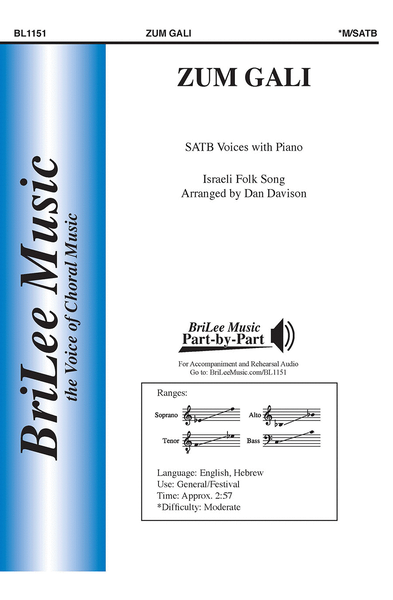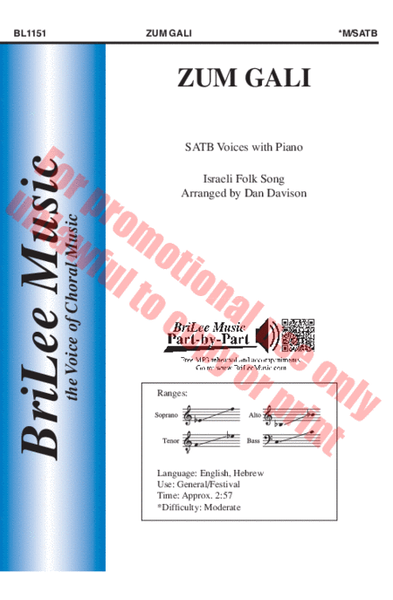Details
Description
SKU: CF.BL1151
Composed by Israeli Folk Song. Arranged by Dan Davison. Sws. Octavo. 16 pages. Duration 2 minutes, 57 seconds. BriLee Music #BL1151. Published by BriLee Music (CF.BL1151).UPC: 672405010023. 6.875 x 10.5 inches. Key: F minor. Israeli Folk song.
Davison's wonderful arrangement of this spirited Israeli folksong is well-suited for mixed choirs needing limited ranges in the tenor and bass parts. The piano accompaniment adds extra excitement to accompany the rhythmically diverse vocal parts. A must sing!.
Zum Gali is an Israeli folk song that originated near the end of World War II, around 1948. At that time, the nation of Israel was just being established, and the "pioneers" mentioned in the song refer to the people who came to Israel in its fledgling days. The song had previously been used as a "work" song. The steady beat in the song lends itself to repetitive chores, such as digging. The piece is divided into two distinct sections. Measures 1-42 maintain the traditional tempo, suitable for working. In m. 43, the tempo suddenly increases, and the song changes from a work song to a song of celebration. In this section, the articulations in all parts will be particularly important. Accents and tenutos should be exaggerated in order to give the second half of the song a very percussive feel. Care has been taken to keep the tenor and bass parts in limited ranges, so as to make the piece accessible for a wide variety of choirs.
Zum Gali is an Israeli folk song that originated near the end of World War II, around 1948. At that time, the nation of Israel was just being established, and the “pioneers” mentioned in the song refer to the people who came to Israel in its fledgling days. The song had previously been used as a “work” song. The steady beat in the song lends itself to repetitive chores, such as digging.The piece is divided into two distinct sections. Measures 1–42 maintain the traditional tempo, suitable for working. In m. 43, the tempo suddenly increases, and the song changes from a work song to a song of celebration. In this section, the articulations in all parts will be particularly important. Accents and tenutos should be exaggerated in order to give the second half of the song a very percussive feel.Care has been taken to keep the tenor and bass parts in limited ranges, so as to make the piece accessible for a wide variety of choirs.
Zum Gali is a Hebrew folk song that originated near the end of World War II, around 1948. At that time, the nation of Israel was just being established, and the “pioneers” mentioned in the song refer to the people who came to Israel in its fledgling days. The song had previously been used as a “work” song. The steady beat in the song lends itself to repetitive chores, such as digging.The piece is divided into two distinct sections. Measures 1–42 maintain the traditional tempo, suitable for working. In m. 43, the tempo suddenly increases, and the song changes from a work song to a song of celebration. In this section, the articulations in all parts will be particularly important. Accents and tenutos should be exaggerated in order to give the second half of the song a very percussive feel.Care has been taken to keep the tenor and bass parts in limited ranges, so as to make the piece accessible for a wide variety of choirs.


 Share
Share